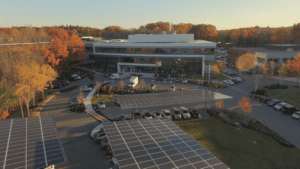
The transmission grid is responsible for carrying electricity from generation sources to consumers. However, as demand for electricity grows and new renewable energy sources are added, the grid can become congested. This can lead to increased transmission costs and reduced system reliability. Moreover, the US transmission grid is aging and in need of repair and replacement.
According to the North American Electric Reliability Corporation, the average age of a transmission line in the US is 40 years. And a 2020 report by the National Renewable Energy Laboratory found that the US needs to invest $1.5 trillion in transmission infrastructure over the next 20 years to meet its clean energy goals. The issue is that building a new infrastructure would take too long.
Fortunately, new tools can support the current infrastructure. One method to assess grid capacity is a technology called dynamic line rating.
Dynamic line rating is a technology that allows transmission system operators to safely increase the capacity of existing transmission lines by monitoring and accounting for real-time environmental conditions.
Dynamic line rate systems increase efficiency
So, how can we impact the transmission grid immediately to support the issues above?
According to a market report from GridStrategies, grid congestion costs totaled $20.8 billion in 2022. Traditionally, transmission system operators have used static line ratings, which are based on conservative assumptions about environmental conditions. However, dynamic line rating (DLR) systems can monitor factors such as ambient temperature, wind speed, and solar radiation to calculate a more accurate line rating in real-time. This results in the grid operator to better balance loads, allowing for increased flexibility and efficiency of the grid.
Data has shown that DLR technologies exceeded static reference ratings by 9-33% in winter months and 26-36% in summer months. On average, DLR exceeded static ratings over 85% of the time.
This is why Schneider Electric partnered with Prisma Photonics in 2022. The company, which began in 2017, has created an invaluable PrismaPower system to monitor grids efficiently. If there is an optical ground wire fiber cable present on the grid, the PrismaPower product utilizes this cable to measure wind metrics on every powerline span and accurately perform DLR calculations in real-time.
Grid capacity improvement
One of the benefits of using the optical ground wire fiber cable that’s already present on the grid infrastructure is that no other sensors or products are required to be installed on the conductors themselves or on towers.
The patented Hyper-Scan Fiber-Sensing™ technology, along with machine learning providing real-time insights and responding to safety and operational scenarios. To utilize this step-change technology, users simply connect an optical interrogator (Beacon 3) unit into an optical fiber.
In addition to providing a DLR calculations, PrismaPower also offers several other important features to help support the grid operator. PrismaCapacity, for one, increases grid capacity via DLR and ambient adjusted rating (AAR). Meanwhile, PrismaClimate provides a real-time assessment of weather conditions like high wind, ice (galloping), and tension. Next, PrismaCircuit provides an understanding of critical or potential failures like short circuits, partial discharge, or vegetation hits.
Transmission grid improvements are crucial
The demand for electricity is increasing. The US Energy Information Administration projects that electricity demand will increase by 1.6% per year on average through 2050. This increase is being driven by factors such as population growth, economic growth, and the electrification of transportation.
A 2022 report by the Federal Energy Regulatory Commission (FERC) found that there was a “significant backlog” of transmission projects waiting to be approved and built. This backlog was due to a number of factors, including permitting delays, environmental concerns, and opposition from local communities.
Understandably, the FERC has approved a new final rule going into effect July 2025. It will require all US transmission providers to use ambient-adjusted ratings as the basis for evaluating near-term transmission service. This will be used to increase the accuracy of near-term line ratings. It will also efficiently utilize the nation’s grid and lower costs, improving accuracy and transparency of transmission line ratings.
Europe doesn’t currently have a similar requirement. But there are overarching requirements on transmission system operators to support clean energy transition as it relates to grid capacity. The EU does have goals of reducing emissions by 55% by 2030, and with that has created a path to digitize its power grid with an investment of $580 billion into digitization.
How to quickly increase grid capacity
The need for a DLR technology is increasingly important in the US and Europe. The data clearly shows a need to invest in transmission grid capacity to ensure that the grid is able to meet the needs of the future. Incorporating dynamic line rating systems into existing grids also enables the integration of renewable energy resources and the increasing demand for electricity.
Learn more about how PrismaPower can improve the transmission grid capacity for the generations to come.




Add a comment